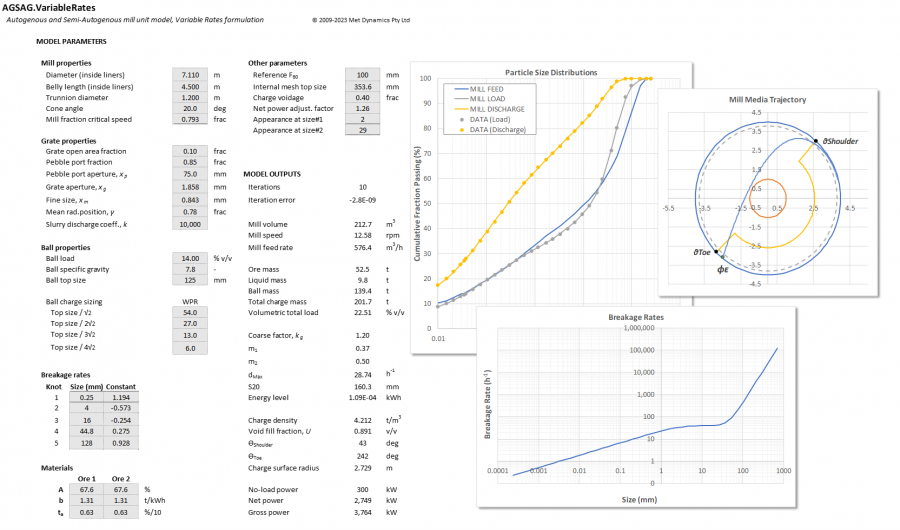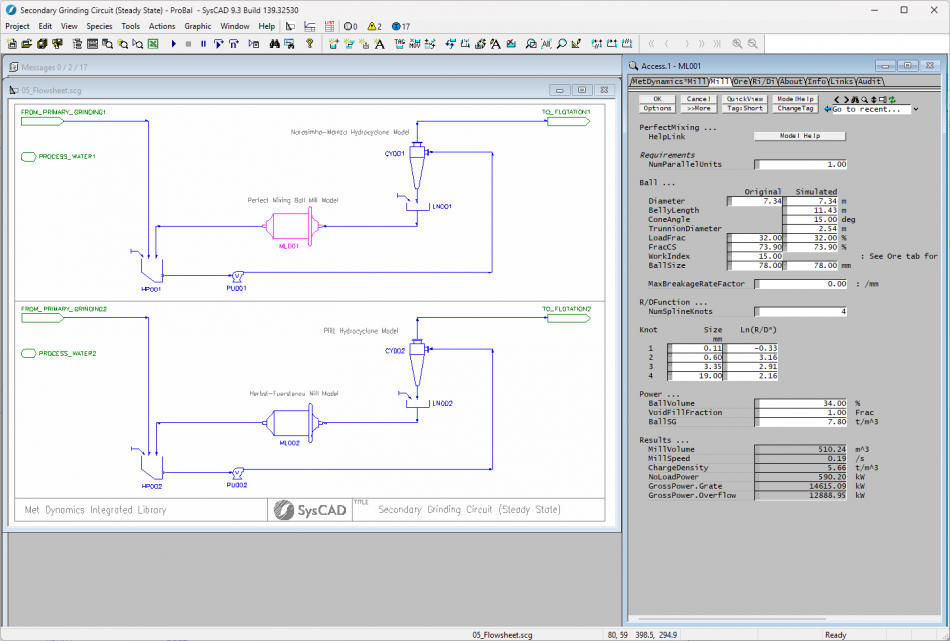Overview
Introduction
Unit models available include:
|
Calculation tools include:
|
Met Dynamics Models is a comprehensive library of unit operation process models, calculation tools and commonly used equations for mineral processing.
Users are able to quickly deploy models and methods usually only available in proprietary flowsheet simulators, complex spreadsheets or as equations in published media.
The Met Dynamics Models equations and methods are sourced from published material such as text books, scientific journal articles, conference proceedings and other media.
An up-to-date list of available models and tools may be found in the Release Notes. Full technical documentation is provided with this wiki.
The Met Dynamics Models library is written entirely in the C++ programming language and is available for both Windows and Linux systems.
Several interfaces to third-party software applications are available, such as:
- Microsoft Excel Add-In (XLL)
- SysCAD (Steady-State and Dynamic)
- Limn The Flowsheet Processor
- C++ and Python Application Programming Interfaces (API)
The interfaces are described in more detail below.
Excel

Microsoft Excel is the simplest and most flexible interface available for the Met Dynamics Models library. The interface is available via the Met Dynamics Models Microsoft Excel Add-In included with all Met Dynamics Models distributions.
Met Dynamics Models may be combined with the full range of Excel functionality, e.g.:
- Employ Excel data manipulation, analysis tools and formulas to curate and arrange raw input data
- Present model results directly with charts and visualisations
- Fit model parameters to sample data with Excel Solver
- Quickly deploy models for large scale analyses with autocomplete, e.g. one unit operation model per Excel row, up to 1,048,576 rows available
Met Dynamics Models can be seamlessly integrated into new or existing Excel spreadsheets with simple cell formula function calls.
For example, the well-known Whiten crusher unit model may be invoked with the cell formula:
=mdUnit_Crusher_Whiten(Parameters as Range, Size as Range, CrusherFeed as Range, Appearance as Range, Ecst10Size as Range)
Model results are presented as an m x n dynamic array of cells. Model results are treated as any other Excel formula and automatically recalculated as necessary.
Some of the advantages of the Met Dynamics Models Microsoft Excel Add-In include:
- Call complex unit models or functions with one Excel formula
- No need to recall complex equations regularly used in mineral processing
- No time wasted constantly recreating simple functionality in Excel (e.g. converting mass retained to cumulative passing, interpolation, etc.)
- Minimise typing errors or mis-formulations
- Models are available to all Excel sheets created or opened on a hosted PC, no need to copy across Visual Basic For Applications (VBA) code
- No macros are used, and Met Dynamics Models Excel files may be distributed in *.xlsx format
The Met Dynamics Models Microsoft Excel Add-In is built with Microsoft's Excel C API, which means fast, CPU-optimised, multi-threaded execution with no OLE/COM data marshalling, code interpretation or .NET requirements.
Met Dynamics Models formulas are self documenting from the Excel formula bar. Typing any formula with no function arguments will print help text. This minimises user manual or wiki look ups when deploying a new function, speeding up user workflow.
A full index of models and functions available in the Excel interface is available here.
SysCAD

Met Dynamics Models tools and unit models are available for the SysCAD process simulation platform. Met Dynamics Models are included as native SysCAD unit models which extend and improve on existing SysCAD functionality.
This allows the full range of metallurgical processing to be integrated in a single simulation platform; from mineral processing (comminution, classification and concentration) to hydrometallurgical and pyrometallurgical extraction.
Both Steady-State and Dynamic SysCAD simulation modes are supported.
A full index of models and functions available in the SysCAD interface is available here.
Met Dynamics Models further includes a subset of unit models with true dynamic simulation capability, not available in Excel (listed here).
See SysCAD.net more information about SysCAD software.
Limn - The Flowsheet Processor
The Met Dynamics Models Microsoft Excel Add-In works with Limn - The Flowsheet Processor. Deploy Met Dynamics Models to extend and improve the predictive capability of Limn flowsheet models.
See Limn - The Flowsheet Processor more information about Limn.
API
Experienced programmers may access the Met Dynamics C++ or Python API directly. This allows users to integrate Met Dynamics Models with their own software applications.
For example, a recently deployed Windows desktop application used the Met Dynamics Models Whiten crusher unit to estimate the particle size distributions of primary crushed product from an underground block cave. Over 50 million rows of ore and drawpoint data were processed by the multi-threaded application, an otherwise impractical task in other platforms like Excel.
Roadmap
An extensive roadmap for future Met Dynamics Models releases exists, including new and improved models, tools and interfaces.
Please contact support@metdynamics.com.au for further information or to suggest new functions and capabilities to suit your needs.